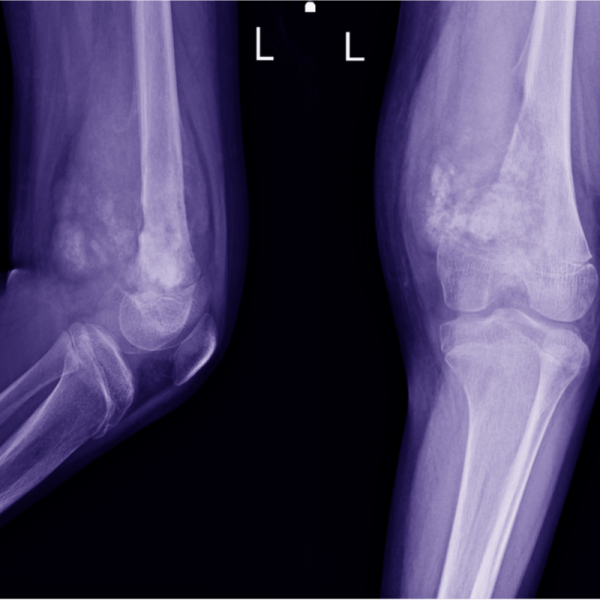
What is osteosarcoma?
An osteosarcoma is a malignant bone cancer and arises from the cells of the basic bone substance, the so-called bone matrix. Along with chondrosarcoma ( ) and Ewing's sarcoma, osteosarcoma is the most common form of bone cancer, with an above-average incidence among adolescents and young adults. If the tumour is diagnosed and treated at an early stage, the disease can usually be treated well.
What stages is osteosarcoma divided into?
Like other forms of bone cancer, osteosarcoma is divided into the following stages according to the so-called TNM system with regard to tumour size (T), the presence of lymph node metastases (N) and other distant metastases (M):
- Tumour size (T): TX (primary tumour which cannot be assessed), T0 (no sign of a primary tumour), T1 (tumour which is no larger than 8 cm), T2 (tumour which is larger than 8 cm), T3 (metastasis)
- Lymph node metastases (N) (Nodi lymphatici): N0 (neither local nor neighbouring lymph nodes are affected by the cancer), N1 (regional lymph node metastases are present), NX (the regional lymph nodes cannot be assessed)
- Distant metastases (M): M0 (no distant metastases are present), M1 (distant metastases are present), M1a (lung metastases are present), M1b (other distant metastases are present), MX (assessment of distant metastases is not possible)
In addition, osteosarcoma, like other types of cancer, is classified by what is known as grading. Doctors use this term to describe the following pathological changes in tumour cells:
- G1: less malignant cancer cells,
- G2: moderately malignant cancer cells,
- G3: malignant cancer cells,
- G4: highly malignant cancer cells,
- GX: malignancy of the tumour cannot be assessed
What are the causes of osteosarcoma?
Doctors have not yet been able to clarify the exact causes of osteosarcoma. However, they assume that genetic factors, rapid bone growth, especially at a young age, as well as chronic bone diseases and radiation therapy due to a previous cancer can play a role in its formation.
How does osteosarcoma manifest itself?
The first signs of an osteosarcoma usually manifest themselves where the tumour is located. In many cases, the tumour of an osteosarcoma may hurt and swell. The pain can increase in intensity, especially when the bone is strained. The swelling may feel hot and cause redness or a greyish discolouration.
In addition, there may be limited mobility, which occurs especially when the tumour has developed at the joints. A typical sign of osteosarcoma is brittle bones. This is because in osteosarcoma the cells that would normally form the bone degenerate. Their uncontrolled growth results in unstable bone tissue called osteoid. At a later stage of the cancer, when the osteosarcoma has already metastasised, more non-specific symptoms such as fever, unwanted weight loss, fatigue and/or poor performance may also occur.
How is osteosarcoma diagnosed?
Because of its rather non-specific symptoms, bone cancer tends to be diagnosed late. This is usually the case when it has already metastasised, i.e. the osteosarcoma has already spread through the blood and lymph channels in the body.
The usual imaging methods are used for diagnosis. These include X-rays, computer tomography (CT), magnetic resonance imaging (MRI), bone scintigraphy or positron emission tomography (PET). However, a tissue sample (biopsy) and a blood test are also performed to make a definite diagnosis. Although there are no specific tumour markers in the blood that exclusively indicate osteosarcoma, some abnormalities in the blood can give doctors clues about osteosarcoma. These include, for example, the elevated enzymes of alkaline phosphatase and lactate dehydrogenase (LDH) in the blood serum. As these values should normally decrease during successful chemotherapy, they also serve to monitor the success of the therapy.
How is osteosarcoma treated?
The treatment of an osteosarcoma depends on the size of the tumour, its location and the stage of the cancer. The general state of health also determines the treatment. The therapy for osteosarcoma is always tailored to the individual patient and usually consists of chemotherapy and/or radiotherapy and/or surgery.
During chemotherapy, the patient is given special drugs to inhibit the division and growth of the fast-growing cells in order to prevent the cancer from spreading. Chemotherapy is often given before the tumour is surgically removed (neoadjuvant chemotherapy) in order to shrink the tumour.
Surgery should remove as much harmful tissue as necessary and as little healthy tissue as possible. It is important that, if possible, no cancer cells are left behind. Depending on the severity of the tumour, amputation may be necessary. This could be the case if, for example, there are very large bone tumours in the arm or leg. In this case, doctors will aim for a so-called extremity-preserving operation. This means that the removed bone tissue is replaced either with an artificial substitute or other bone.
Radiotherapy is given if the tumour is difficult to reach surgically, which is the case, for example, with a tumour on the spine or on the bones of the skull or face. However, radiotherapy can also be prescribed if the tumour has not responded well to previous chemotherapy.
What is the prognosis for osteosarcoma?
As with any form of bone cancer, if the disease is left untreated, it will become fatal within a few years. But even with treatment, the patient is not considered cured in the true sense of the word. However, after successful therapy, the patient has a good chance of remaining tumour-free for a long time. The right treatment can therefore push the tumour back, although the patient must expect relapses or late effects at any time. However, if the osteosarcoma has already metastasised, the patient's prognosis deteriorates accordingly.
